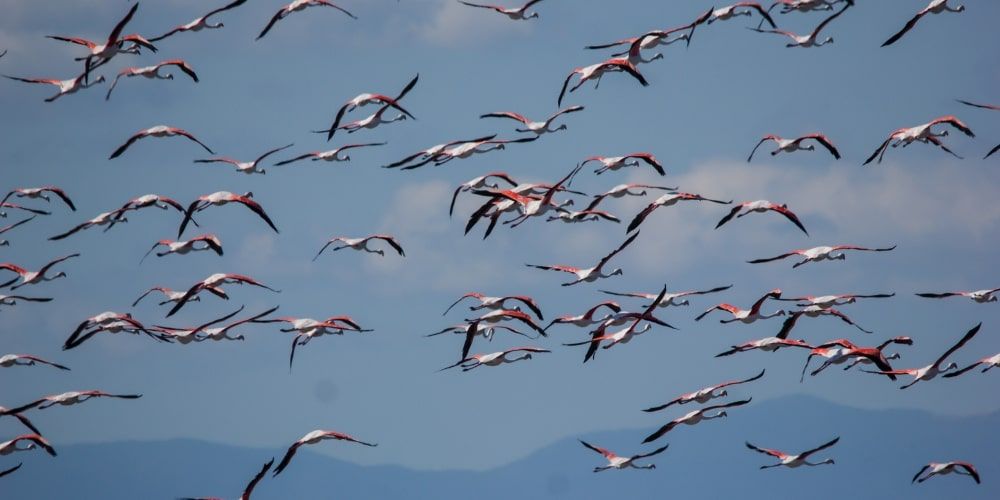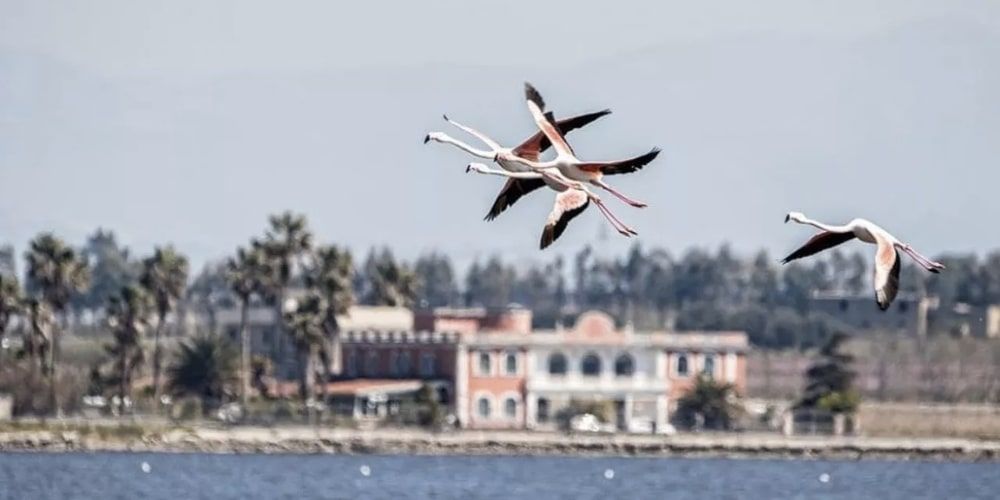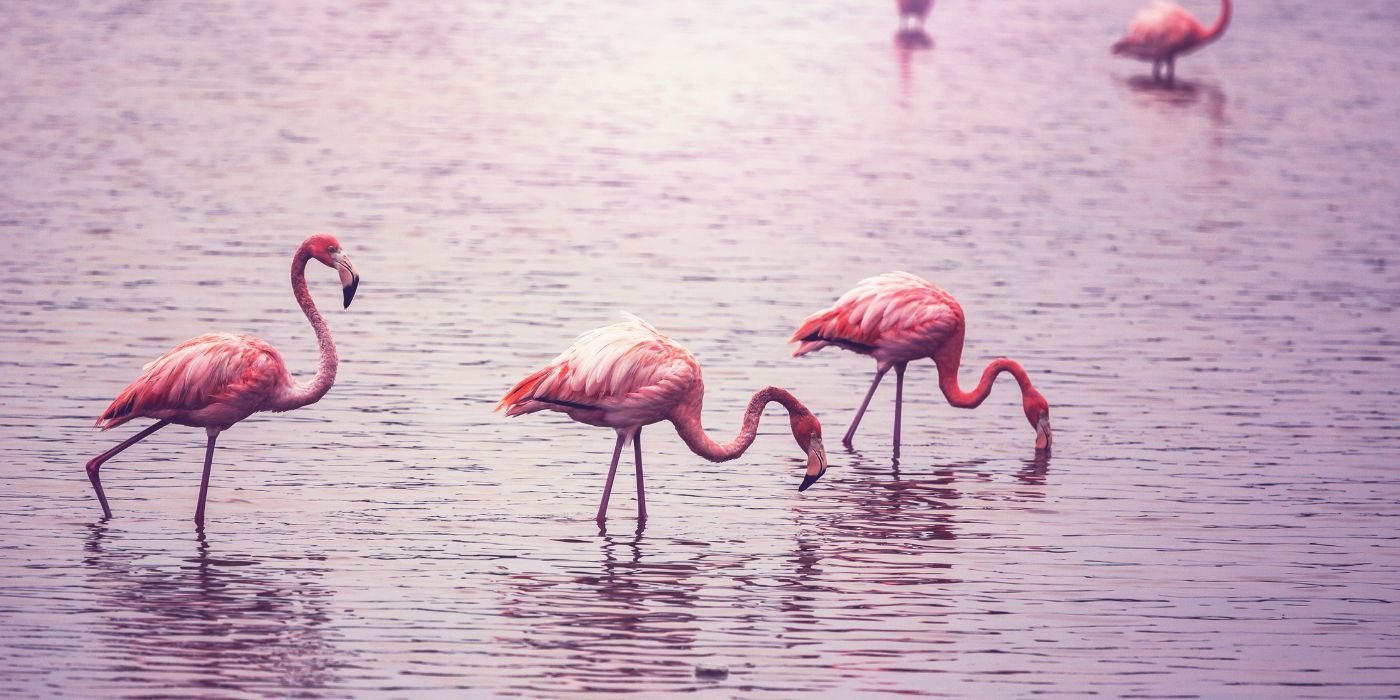An enchanting example of bird that has fascinated, over time, many artists, poets and writers like Pablo Neruda, who dedicates the poem "Flamenco": pink flamingos, with their purple feathers, are linked to the myth of the phoenix. The firebird rising from the ashes.
In Italy the presence of flamingos is increasingly widespread. But it has not always been so: until a few years ago, in fact, the flamingo in Italy was considered a rare species. Accomplices the conservation actions implemented since the late seventies and the many interventions made in the protected areas, the improvement of environmental conditions, the decrease in poaching and disturbance, the presence in Italy of these magnificent birds has increased considerably. Proof that these adorable pink waders love Italy more and more!
We at Visit Italy have followed these "Mediterranean vagabonds" that, unlike many other species, do not have a precise and always identifiable migratory direction, but wandering, in fact, can be found in unexpected places. Here are the ones we have chosen for you!

Where to see pink flamingos in Italy?

The pink flamingos frequent mainly lagoons, ponds, mudflats, salt pans or in any case very humid soils, provided that the depth of the water never exceeds the metre, but spotting them is not so obvious. In fact, the spectacular nature of these events lies precisely in their unique and unexpected character.
From southern Europe, from Asia, from Africa...every year, the pink flamingos come from these areas to find shelter and, more precisely, to begin the process of nesting, before leaving for a new journey.
Not being predictable to observe them, being to admire them makes this experience even more magical and Italy is certainly among the favorite places for these spectacular birds with long legs. You can have the pleasure of "meeting them" in many places: ready to discover some with us?
5. In the center of Milan the pink flamingos of Villa Invernizzi
In the heart of the Milan fashion district, a few steps from the spectacular Duomo of Milan and in the silence of an Art Nouveau residential area, Via dei Cappuccini number 7 is certainly among the most unusual places to admire the wonderful pink flamingos.
In an unusual and secret Milan, behind the gate of Villa Invernizzi, ancient home of the creator of the cheese Mio, you can in fact observe the cute flamingos walking through the garden, bathing in the pond, they clean the feathers or they eat heedless to have on them the eyes of the passers-by.
The question that has arisen spontaneously is: how did these wonderful specimens end up in the Milanese metropolis? Thanks to the Cavalier Invernizzi, the owner of the villa who besides being a skilled entrepreneur was a lover of nature. Divided between the wishes of his wife Enrica Pessina who dreamed of a life in the city and his own living in the countryside, he decided to move to Milan after importing from South America a colony of flamingos in his garden; contemplating them made him feel at peace with himself.
The pink flamingos we see today are all born in captivity and are the descendants of the specimens imported in the 70s from Chile and Africa. Fortunately, since 1980 this transit of animals is forbidden thanks to Italy’s accession to the Convention on International Trade of the Endangered Species (CITES). The purpose of the Treaty is to protect endangered fauna and flora.
The specimens of Villa Invernizzi are fed with crustaceans and vitamins to preserve the brilliance of the feathers and in addition they cannot take flight because the length of their wings is constantly controlled and regulated, let’s say that they have settled rather well in the urban context of Milan. But if they could fly, where do you think they’d go?
4. Sicilian salt pans, ideal habitat for flamingos
Among salt pans and new oases Sicily seems to be the favorite resting place for pink birds. In particular, the salt pans of Priolo Natural Reserve, in the province of Syracuse, is, unexpectedly, the only flamingo nesting site in Sicily.
Despite the presence of the petrochemical petrochemical plant in the province of Siracusa, an imposing industrial reality that has unequivocally marked the environment, the economy and the health of this magnificent coastal corner of Sicily, the reserve of Priolo is one of the most peculiar naturalistic sites of the island.
Thanks to the incredible work of preservation and enhancement by Lipu, which has been managing this area since summer 2001, today this area is a small corner of paradise sheltered from chimneys and old pipelines abandoned and reclaimed.
Last strip of a vast wetland that occupied a stretch of coast between Priolo and Marina di Melilli, are about 40 hectares of sea, dunes, brackish basins and views of the water that has brought the flamingo pairs from 453 (in 2019) to 809 (in 2020).
There are also other places where you can admire these sugary pink birds: the suggestive salt pans of Trapani and Paceco, the spectacular Vendicari Nature Reserve, the swamp of the salt pans of Augusta...all incredible places that decree Sicily as the region of flamingos.
Visit Vendicari with an exclusive tour between Noto and Marzaremi3. Pink flamingos in Puglia, the other Taranto
The wind in the reeds. The chimneys of the former Ilva as a background.
It is an almost unreal, dystopian landscape, that of the other Taranto, which less than ten km from the Ionian capital hosts a mysterious oasis frequented by pink flamingos and knights of Italy.
Crossed by an icy and very clean river, surrounded by dense vegetation, we find ourselves in front of a Taranto that resists pollution: fortunately, not everything was inevitably compromised.
And while the males face each other to win the favor of the companions, they get up suddenly in flight to make ample turns on the swamp, giving us an unforgettable show.
2. The pond of Molentargius, the Sardinia of flamingos
Resident since 1993, the pink flamingos of the pond of Molentargius, in Sardinia, permanently reside in this oasis, and it is therefore possible to admire them all year round. One of the most important wetlands in southern Italy, this protected area covers 1600 hectares and is a rare example of an ecosystem that has developed in a highly populated area.
The locals here call them "sa genti arrubia", the red people who, in order not to disperse body heat when they are with their legs in the water, have this bizarre and nice propensity to stand on one leg.
An evocative landscape that starting from May turns pink: a soft cloud that wraps everything like a dream and attracts tourists from all over the world. Between the rose of the sunset that mixes with that of the salt pans and that of the ancient buildings, there is that of the flamingos that stand out on this panorama from the magical atmosphere, and at each sunset, that is different from the previous one and from what will come, bewitching pink oases that will remain long in your eyes.
1. In Campania: the flamingos's stop at Lake Patria

The largest coastal lake in Campania. We are on Lake Patria and in this romantic and picturesque landscape, pink flamingos have their home.
Few specimens are sighted on this lake of volcanic origin and composed of salt water that, despite the great threat of pollution and illegal construction, remains an area with a remarkable biodiversity.
Among marsh harriers, herons, wild ducks and waders, the beautiful pink flamingos are a prize for this territory so complicated that never ceases to surprise.
When to sight pink flamingos in Italy?

Being migratory birds, they hardly remain stationed for too long in a place. The nidification, the best moment for spotting the flamingos, happens in spring and in summer, ideal seasons for observing them.
But if you choose the enchanting landscape of one of the salt pans of Sicily, thanks to the mild temperatures, you can find animals that in the imagination of Lewis Carrol become golf clubs, all year round.
The only warning we feel to share, regardless of the location and the season you choose, is to know the strategic points where you can spot these cute pink birds without scaring them or putting them in danger.
About the author
Written on 28/03/2023



Laura Leone
Where to spot pink flamingos in Italy? Here are 5 places you might not expect where you can admire these fascinating migratory birds. Let's go!